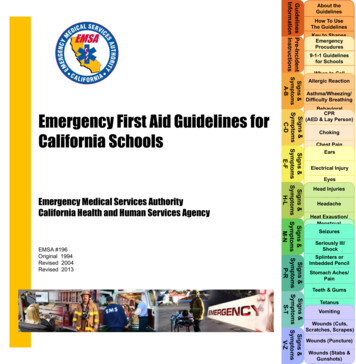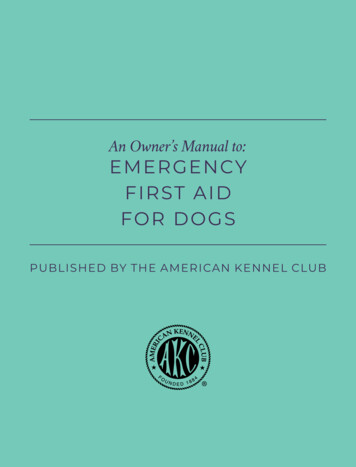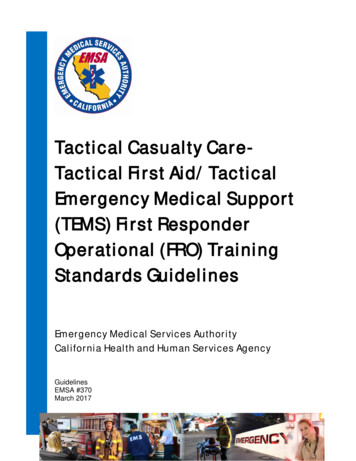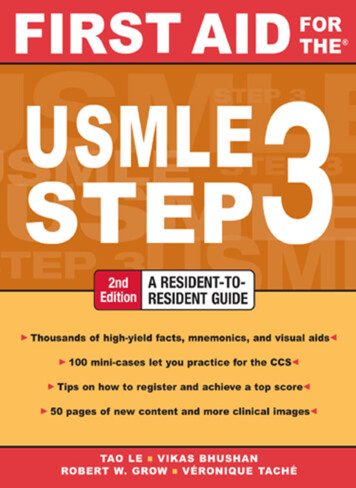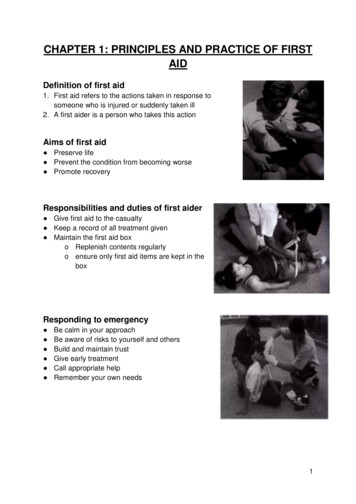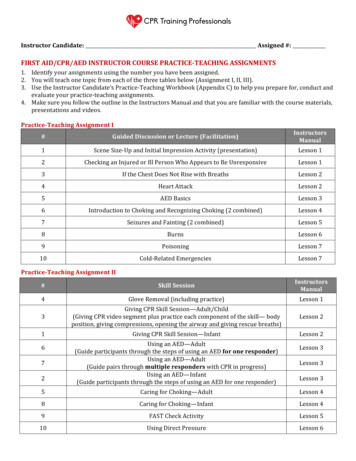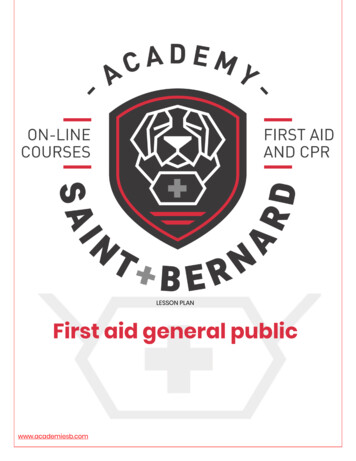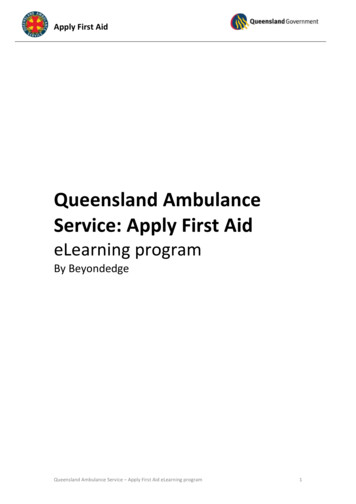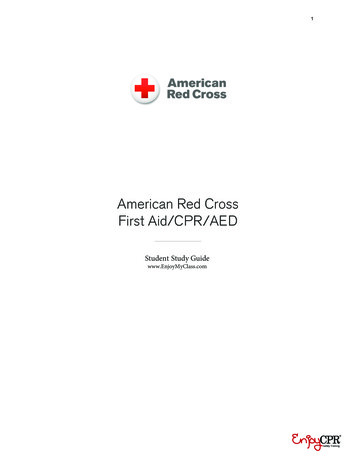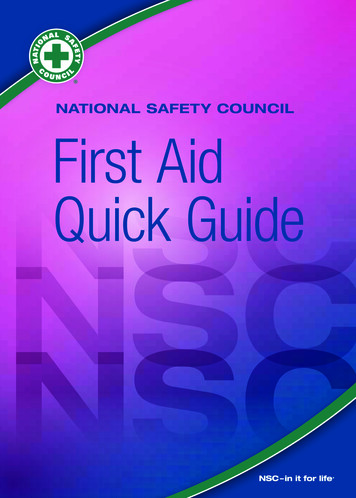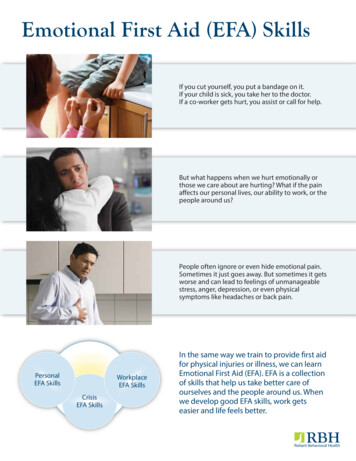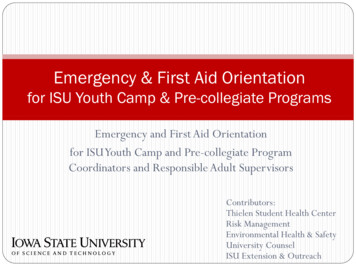
Transcription
Emergency & First Aid Orientationfor ISU Youth Camp & Pre-collegiate ProgramsEmergency and First Aid Orientationfor ISU Youth Camp and Pre-collegiate ProgramCoordinators and Responsible Adult SupervisorsContributors:Thielen Student Health CenterRisk ManagementEnvironmental Health & SafetyUniversity CounselISU Extension & Outreach
Preplanning Familiarize yourself with the emergency action planand building layout for your camp area so you willknow what to do in the event of any emergency. Be alert for potential severe weather and know properemergency procedures. Have a stocked first aid kit readily available and haveappropriate first aid training. Additional emergency procedures information dures
Building Evacuation Maps Look for EvacuationMaps for building(s)you will be in. Maps show exitroutes from building,severe weathershelter areas andlocations of fireextinguishers, pullstations, and otheremergencyequipment. Maps should be posted in buildings or are available onlineat: on.
Calling 911 Calls to 911 from ISU landline phone will reach ISUPolice Dispatch. Calls to 911 from a cell phone will reach off-campusemergency dispatch. Inform them your emergency isat Iowa State University. Be prepared to tell them: your exact location, including building name, androom number, your name and phone number you are calling from,and details of your emergency and what happened.
Reporting CrimesALL crimes or suspected cases of child abuse ormolestation must be reported to ISU DPS as perViolence-Free Campus iolence-Free Campus Policy StatementViolence, threats or implied threats of violence, and intimidation(verbal or physical acts intended to frighten or coerce) impede thegoal of providing a safe environment and will not be tolerated.In addition, abuse of children or dependent adults, or any othervulnerable population is specifically prohibited by this policy.All students, employees, and visitors are covered by this policy.
Fire Assess the situation. Activate the nearest fire alarm. Call 911. Evacuate the building in a calmand orderly manner. Use a fire extinguisher – if you have been trained and if you can do so without riskto yourself. Account for all buildingoccupants after evacuation.For more fire-related information, see: http://www.ehs.iastate.edu/fire
Severe Weather Be familiar with the building’s notification plan. Know where the shelter areas are and how toget to them quickly. Know the terms: Tornado watch –conditions favorable Tornado warning –tornado sighted, move to shelter If outside & sirens go off, seek shelter indoors. Remain in shelter until warning expires ordanger is past.For more weather-related information, see: http://www.ehs.iastate.edu/prep/weather
Medical Emergencies Assess the situation. Do you need an ambulance or just first aid? Call 911 if needed. Ensure scene is safe for you and the personin need of assistance.
What’s In a First Aid Kit ? Kits vary in contents but mostkits have the following items: band-aids / adhesivebandages gauze pads and tape scissors, cold pack wound bandage / compress eye pads / eye wash solution first aid / burn cream antibiotic ointment face shield or barrier mask forproviding CPR Forceps / tweezers Disposable thermometers First aid instruction booklet
Universal Precautions and PersonalProtective Equipment (PPE) Universal Precautions also known as StandardPrecautions is a way to limit the spread of disease bypreventing contact with blood borne pathogens. Bloodborne pathogens include but are not limited to: Hepatitis BVirus (HBV), Hepatitis C Virus (HCV)and HumanImmunodeficiency Virus (HIV). To follow Universal Precautions correctly means whetheror not you think a victim’s blood or body fluid is infected,you act as if it is. All blood and body fluids are consideredhazardous material and should be treated as if infectious. PPE includes disposable gloves, gowns, lab coats, faceshields, eye protection and pocket masks / facial barriers.
Universal Precautions and PersonalProtective Equipment (PPE) continuedTo reduce the risk of infections: Wear disposable gloves when giving first aid. Use a faceshield or mask when performing CPR. Remove gloves properly – without touching the bare skin,grasp the inside palm of your gloves with the fingers of theopposite hand and pull gloves off inside out – repeat with2nd hand and dispose of gloves in an appropriate manner. Clean your hands with an alcohol based hand sanitizer. Ifnot available, wash well with soap, and water.
Emergency Action StepsASSESS: the situation – is it safe?The victim – are they responsive?ALERT: call 911 or activate theemergency action plan.ATTEND: to the victim. Check forlife threatening conditions first.
Adult / Child Choking :Severe Airway Blockage Victim is responsive: Quickly ask, “are you choking?” If the victim nods yes, or is unable to talkspeak, or cough – act quickly. Stand behind the victim Make a fist and place the thumb side of thathand against the victim’s abdomen, just above the navel andbelow the ribs. Grasp fist with the other hand. Quickly thrust inward and upward into the abdomen Repeat thrusts until object is expelled or victim becomesunresponsive.
Adult / Child Choking:Severe Airway Blockage Victim is unresponsive: If needed, help the victim to the groundand alert EMS / call 911. Begin chest thrusts as you would withCPR. Each time the airway is openedlook for the object in the victim’s throatand if you can see it, remove it – beingcareful not to lodge the object further into the victim’s throat. Continue chest thrusts until EMS / Paramedics arrive, or thevictim shows signs of breathing /responsiveness.
Basic First Aid InstructionsMinor WoundsMinor wounds include abrasions, lacerations, punctures and incisions. Themost significant issues to consider with any open wound are control ofbleeding and infection.Signs and Symptoms: Break, cut or opening in theskin Bleeding – may be minor,moderate or severe Bruising and pain Infection Progressing shockFirst Aid: If bleeding, apply directpressure with a clean cloth orabsorbent pad Wash area with antibacterialsoap and clean until thereappears to be no foreignmatter in the wound Cover area with an adhesivebandage or gauze wrap
ShockShock develops when not enough blood flows to the vital organs of the body.Victims with shock may stop responding. Common causes of shock are: Severe bleeding Heart attack or other heart problem Severe allergic reactionSigns and Symptoms: Dizziness, faint or weak feeling Rapid, shallow breathing Anxiety, restlessness, agitation,or confusion Cool and clammy to the touch Pale or grayish skin Thirst Nausea or vomiting Nervous system injuries Severe burns DehydrationFirst Aid: Help person lie on their back. Keep victim lying flat with feetslightly elevated if possible. Cover person to keep themwarm, but prevent overheating. Ensure an open airway for victimand adequate breathing. Monitor victim and administerCPR if necessary.
Minor Wounds – continued:Bruising:Crush Injury: Signs and Symptoms: Signs and Symptoms: Pain and swelling Pain and swellingCaused by broken bloodvessels leaking blood under the skin. Bruisingcan be minimal or large and severe. Discoloration: new bruising will bedark purple / older bruising will fadeto greenish yellowOccurs when a bodypart is subjected to a high degree of force orpressure . Example: smashed fingers in door. Discoloration and sometimes deformity First Aid: First Aid: Apply ice to injury to reduce pain, Apply ice just as you would with ableeding and swelling To prevent frost bite to the injuredarea, place a thin towel or clothbetween the skin and ice. Limit iceapplication to 20 minutes on, 20 offbruising injury If pain is severe and does not lessenwith ice or there is decreased sensation,weakness, or paleness of the skin in theaffected area, seek emergency care
Severe Bleeding Emergency Action Steps: Assess the scene – if the scene is unsafe or becomes unsafe,get out! Only move the patient if absolutely necessary. Assess the victim - Tap shoulder, shout name. No response? Alert – Have someone call 911 for help and get an AED. If youare alone – make the call yourself. Attend to any life threatening problems.
Severe Bleeding continuedApply Direct Pressure: Rip or cut away clothing sowound can be seen. Place an absorbent paddirectly over the wound. Apply firm, direct pressureover the wound. The victim can assist if theyare able.Apply Pressure Bandage: Wrap a conformingbandage securely over thepad to maintain pressureand hold the gauze inplace. Bandage should be looseenough so a finger can slipunder the bandage.
Severe Bleeding continuedIf Bleeding Continues: As the first dressingsbecome soaked with blood,apply more pads, dressingsand maintain firm, directpressure. Do not remove the firstdressings, just continue toadd more if soakingthrough continues.Managing Shock: Ensure an open airway forthe victim and adequatebreathing. Keep the bleeding undercontrol. Prevent chilling oroverheating. Keep victim lying flat withfeet slightly elevated ifpossible.
Burns: Minor / Major Thermal burns are caused by sun, fire, hot liquids or objects andsometimes hot gases. Chemical burns are caused by contact with wet or dry chemicals. Electrical burns are caused by contact with electrical wires,current, or lightening. Burns on the face, hands, feet, and genitals can be particularlyserious. Burns can cause tremendous damage to the body. They can causeextreme pain, scarring, massive infection, organ failure, and evendeath. A rescuer’s highest priority is personal safety. If a victim is on fire, tell him/her to STOP, DROP, and ROLL. If a victim is in contact with electricity DO NOT TOUCH themuntil the source of electricity has been shut off.
Burns: Minor / Major and First Aid CareMinor BurnsMajor Burns Signs and Symptoms: Pain, Redness Swelling, Blisters Signs and Symptoms: First Aid: Expose the burn Cool burns with cold water and First Aid:continue until pain lessens After cooling, cover with a dry,sterile bandage or clean dressing Protect from friction /pressure DO NOT pop blisters or apply anyointment or other substance Dry/leathery, white, or blackened,charred skin Assess/Alert/Attend to any lifethreatening problems Call 911and Activate EMS If caused by a liquid chemical, flushwith large amounts of water rightaway if you are fully trained in FirstAid
Bites and StingsBites and stings that could require first aid care can occurfrom a wide variety of sources. Most only cause minordiscomfort and can easily be treated by a first aid provider.However bites and stings from venomous snakes, insects oranimals can cause intense pain and swelling. Bites fromhumans and animals such as dogs, cats, bats etc. can causesevere injury and infection, including tetanus and rabies.Some people have severe allergic reactions to bites orstings that can be life threatening. In these cases, the mostimportant first aid measure is rapid access to advancedemergency medical care.
Bites and Stings First Aid General Signs andSymptoms associated withbites and stings: redness swelling pain itching nausea problems breathing General First Aid for bitesand stings: remove jewelry andconstrictive clothing wash the area with soapand clean water cover the area with anadhesive bandage or gauzewrap apply ice if needed toreduce pain and swelling
Eye InjuriesEye injuries can range from minor irritations to severe and sightthreatening. Injuries are frequently caused by objects in the eye, burns, andblunt force injuries. Any of these conditions or situations can lead topermanent loss of vision.What can you do to prevent an eye injury?Wear protective eyewear during risky activities. Wear safety glasseswith side shields anytime you might be exposed to flying particles, objectsor dust. Wear goggles when exposed to chemicals — even if you're just abystander. Protective eyewear counts during sports, too. Any sportfeaturing a ball, racket or flying object poses a potential risk of eye injury.Take caution with chemicals and cleaners. Carefully read the labelsof chemicals and household cleaning supplies, such as bleach, before usingthem. Don't mix products. Keep all chemicals and sprays in safe areas.
Eye Injuries and First Aid Signs and Symptoms: First Aid Interventions: Pain, redness, stinging Rinse eye with saline solution Burning, itching Bleeding/bruising in oraround eyes Sensitivity to light Decreased or double vision Loss of vision Something actually visiblystuck in eyeor tap water if saline is notavailable. Do not try to remove object Do not allow the victim torub or apply pressure to theinjured eye Cover the eye lightly with agauze pad or clean cloth Seek medical attention
Nosebleeds and First AidMost nosebleeds are not serious and can be handled by a first aidresponder. Most will stop on their own or with simple first aidactions. In some cases nosebleeds can indicate a more seriouscondition which may require ongoing medical attention.If the nose bleed is related to an injury, the victim should be assistedin finding medical assistance urgently.Some people may be taking medications that make them more proneto bleeding. These people should also seek care urgently.
Nosebleeds and First AidSigns andsymptomsto monitor: Bleedingfrom one orboth nostrils Bleeding inthe back ofthe throat,causing thevictim tovomit blood First Aid Interventions: Sit upright and lean forward. By remaining upright,you reduce blood pressure in the veins of your nose. Thisdiscourages further bleeding. Sitting forward will helpyou avoid swallowing blood, which can irritate yourstomach. Have the victim spit out blood that collects inthe back of the throat or mouth. Pinch the nose firmly. Use your thumb and indexfinger to pinch your nostrils shut. Breathe through yourmouth. Continue to pinch for five to 10 minutes.Pinching sends pressure to the bleeding point on thenasal septum and often stops the flow of blood. To prevent re-bleeding, don't pick or blow your noseand don't bend down for several hours after the bleedingepisode. During this time remember to keep your headhigher than the level of your heart.
Diabetes and Diabetic EmergenciesDiabetes is a chronic condition that causes an imbalance of bloodsugar and insulin. Emergencies can occur if someone’s blood sugarbecomes very high or very low. Several factors can contribute tohypoglycemia in people with diabetes, including taking too muchinsulin or other diabetes medications, skipping a meal, or exercisingmore or at a higher intensity than usual.
Hypoglycemia (Low Blood Sugar)Signs and Symptoms: Shakiness Dizziness Sweating Hunger Irritability or moodiness Anxiety or nervousness Headache, vision problems Drowsiness SeizuresFirst Aid Interventions: Five to six pieces of hard candy Four ounces of fruit juice orregular — not diet — soda One tablespoon of sugar, jelly orhoney Three glucose tablets (availablewithout a prescription at mostpharmacies) **Above interventions only ifvictim is alert – if not alert orappears confused, call 911.
Heat Exhaustion & Heat StrokeCauses of heat exhaustion include exposure to high temperatures,particularly when combined with high humidity, and strenuousphysical activity. Without prompt treatment, heat exhaustion canlead to heatstroke, a life-threatening condition. Fortunately, heatexhaustion is preventable.Heatstroke occurs if your body temperature continues to rise. At thispoint, emergency treatment is needed. In a period of hours,untreated heatstroke can cause damage to your brain, heart, kidneysand muscles. These injuries get worse the longer treatment isdelayed, increasing your risk of very serious complications.
Heat Exhaustion First AidSigns and Symptoms: Cool, moist skin with goose bumps when in the heatHeavy sweatingFaintnessDizzinessFatigueWeak, rapid pulseLow blood pressure upon standingMuscle crampsNauseaHeadacheFirst Aid Interventions: Stop all activity and rest Move to a cooler place Drink cool water or sportsdrinks Contact your doctor if yoursigns or symptoms worsen orif they don't improve withinone hour. Seek immediatemedical attention if yourbody temperature reaches104 F (40 C) or higher.
Heat Stroke First AidSigns and Symptoms: High body temperature. A body temperature of 104 F(40 C) or higher is the main sign of heatstroke. A lack of sweating. In heatstroke brought on by hotweather, skin will feel hot and dry to the touch. Nausea and vomiting. Victim may feel sick to theirstomach or vomit. Flushed skin. Skin may turn red as body temperatureincreases. Rapid breathing. Breathing may become rapid andshallow. Racing heart rate. Pulse may significantly increasebecause heat stress places a tremendous burden on theheart to help cool the body. Headache. Victim may experience a throbbing headache. Confusion. Victim may have seizures, hallucinate, or havedifficulty speaking or understanding what others are saying.First Aid Interventions: If you think a person may beexperiencing heatstroke, seekimmediate medical help. Call 911or your local emergency servicesnumber. Help the person move to a shadedlocation and remove excessclothing. Place ice packs or cold, wet towelson the person's head, neck, armpitsand groin. Mist the person with water while afan is blowing on him or her.
First AidA well-stocked first-aid kit can help you respondeffectively to common injuries and emergencies. Keep atleast one first-aid kit in your home, office and one inyour car. Store your kits in easy to retrieve locations thatare out of the reach of young children.You can make a difference for someone when you applyyour knowledge of First Aid.
Bites and stings that could require first aid care can occur from a wide variety of sources. Most only cause minor discomfort and can easily be treated by a first aid provider. However bites and stings from venomous snakes, insects or animals can cause intense pain and swelling. Bites from h
